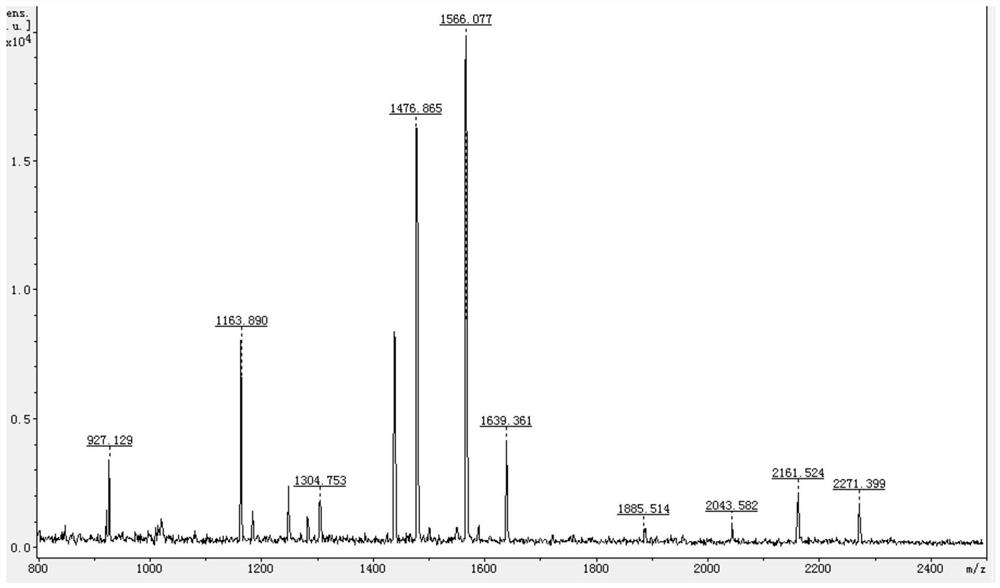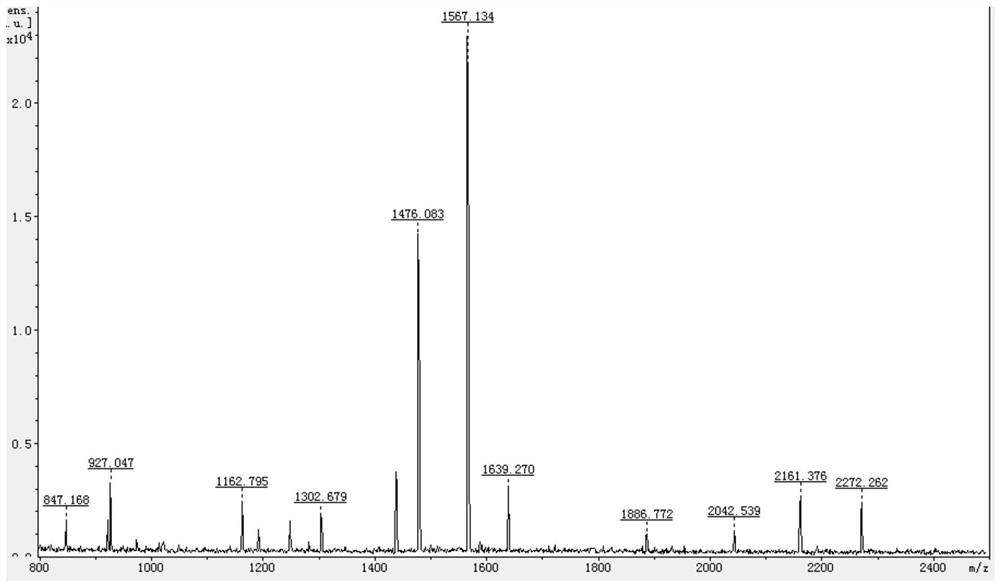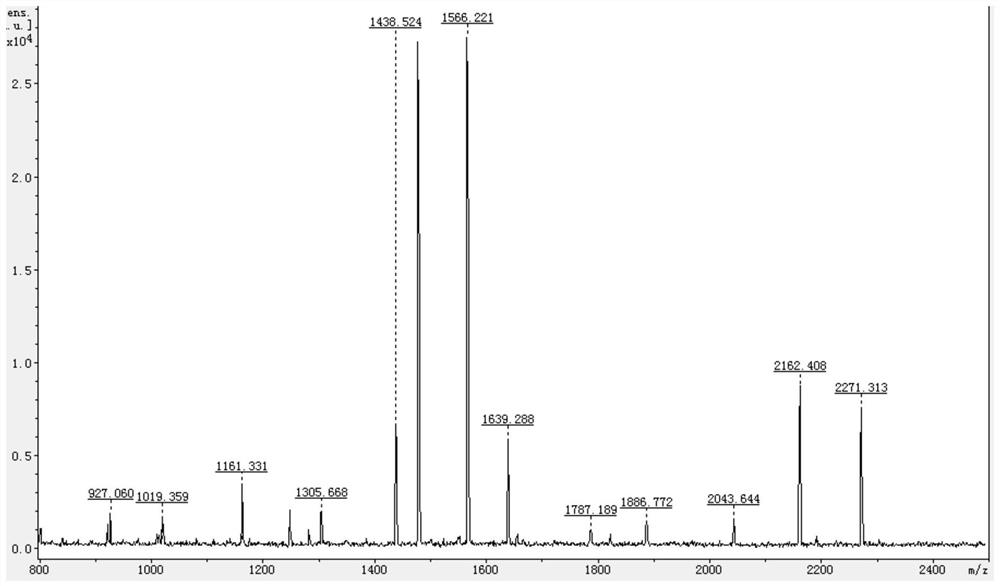Enzymatic hydrolysis of proteins and glycoproteins
A protein and glycoprotein technology, applied in the fields of biology and chemistry, can solve the problems of loss of protein and enzyme, time-consuming, complex enzymatic hydrolysis process, etc., and achieve the effect of fast enzymatic hydrolysis and easy operation.
- Summary
- Abstract
- Description
- Claims
- Application Information
AI Technical Summary
Problems solved by technology
Method used
Image
Examples
Embodiment 1
[0072] Example 1. In situ rapid proteolysis of the target plate
[0073] 1. Enzymatic hydrolysis of BSA
[0074] The BSA used is the product of Sigma-Aldrich Company.
[0075] a) NH 4 HCO 3 Concentration optimization
[0076] 1. Weigh 100mg of BSA standard protein with 100mL ddH 2 Dissolve O, put it into boiling water and boil for 10 minutes, then put it into an ice-water mixture to cool to obtain a 1 mg / mL denatured BSA solution; use deionized water to dissolve Tripsin to obtain a Tripsin aqueous solution with a Tripsin concentration of 100 ng / μL;
[0077] 2. Dilute 1 mg / mL denatured BSA solution with deionized water to obtain a denatured BSA solution with a BSA concentration of 100 ng / μL; 1 μL 100 ng / μL denatured BSA solution, 1 μL 100 ng / μL Tripsin aqueous solution, 1 μL NH 4 HCO 3 50mM NH 4 HCO 3 The aqueous solution and 7 μL of deionized water were quickly mixed to obtain a reaction mixture. In the reaction mixture, the concentrations of BSA and Tripsin were both ...
Embodiment 2
[0099] Example 2. Rapid enzymolysis of protein in liquid
[0100] 1. Weigh 200mg of BSA standard protein with 100mL ddH 2 O was dissolved, boiled in boiling water for 10 minutes, and then cooled in an ice-water mixture to obtain a 2 mg / mL denatured BSA solution;
[0101] 2. Dilute the 2 mg / mL denatured BSA solution in step 1 with deionized water to obtain a 400 ng / μL denatured BSA solution; take 25 μL of the 400 ng / μL denatured BSA solution, add 50 μL 50 mM NH to it 4 HCO 3 Aqueous solution and 25μL 200ng / μL Tripsin aqueous solution, after mixing evenly (the mass ratio of BSA and Tripsin in the reaction system obtained after mixing is 2:1, the concentration of Tripsin is 50ng / μL, NH 4 HCO 3 The concentration of 25mM) was incubated for 5 minutes at 37°C and 1200rpm (to increase the contact opportunity of protein and enzyme, using a dry thermostat (THERMO-SHAKER)) to obtain the enzymatic hydrolysis product.
[0102] 3. After the enzymatic hydrolysis in step 2, dilute the enz...
Embodiment 3
[0105] Embodiment 3, the comparison of the enzymatic hydrolysis method of the present invention and the traditional enzymatic hydrolysis method
[0106] 1. Traditional methods
[0107] 1. Weigh 200mg of BSA standard protein with 100mL ddH 2 O was dissolved, boiled in boiling water for 10 minutes, and then cooled in an ice-water mixture to obtain a 2 mg / mL denatured BSA solution.
[0108] 2. Dilute the 2 mg / mL denatured BSA solution in step 1 with deionized water to obtain a 20 ng / μL denatured BSA solution; take 25 μL of the 20 ng / μL denatured BSA solution, add 50 μL of 50 mM NH to it 4 HCO 3 Aqueous solution and 25 μL 0.4ng / μL Tripsin aqueous solution, after mixing evenly (the mass ratio of BSA and Tripsin in the reaction system obtained after mixing is 50:1, NH 4 HCO 3 The concentration of 25mM) was incubated at 37°C and 1200rpm for 12 hours to obtain the enzymatic hydrolysis product.
[0109] 3. After the enzymatic hydrolysis in step 2, take 1 μL of the enzymatic hydrol...
PUM
| Property | Measurement | Unit |
|---|---|---|
| volume | aaaaa | aaaaa |
| volume | aaaaa | aaaaa |
Abstract
Description
Claims
Application Information
 Login to View More
Login to View More - R&D
- Intellectual Property
- Life Sciences
- Materials
- Tech Scout
- Unparalleled Data Quality
- Higher Quality Content
- 60% Fewer Hallucinations
Browse by: Latest US Patents, China's latest patents, Technical Efficacy Thesaurus, Application Domain, Technology Topic, Popular Technical Reports.
© 2025 PatSnap. All rights reserved.Legal|Privacy policy|Modern Slavery Act Transparency Statement|Sitemap|About US| Contact US: help@patsnap.com



